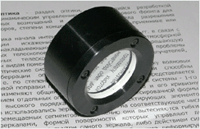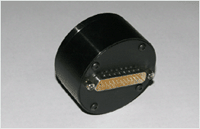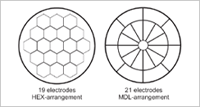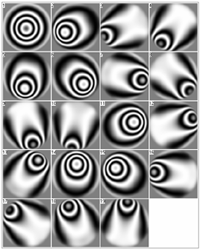|

Fig. 1

Fig. 2

Fig. 3

Fig. 4
|
A
bimorph (unimorph) deformable mirror
(fig. 1, 2) is
constructed of two (one) thin plate(s) of
piezoelectric material
coupled with a substrate plate. The electrode pattern is
deposited on the piezo-plates, which are then glued together to
form a sandwich of
electrodes. The ground
plane is the common middle surface of the bimorph or the back
surface of the substrate in the unimorph. An
optical surface is
formed on the front surface of the substrate plate. The
polarization of the piezoelectric plate is chosen so that to
make the plate expand or contract when voltage is applied to the
electrode. The differential expansion/contraction of the
substrate and piezo-plates causes the bimorph (unimorph) to
bend, much in the same way as a bi-metallic strip will bend when
heated.
The typical arrangement of
mirror electrodes is shown in
fig. 3.
As a result of such an arrangement, the mirrors are capable of
forming complex
surface reliefs, the
shape of which is computer-controlled. Measured
response functions
of deformable mirror
electrodes shown in
fig. 4.
The deformable mirrors of
this type are designed to be applied in
medical imaging,
laser beam control and
shaping,
optical communications,
and astronomy.
TECHNICAL SPECIFICATION:
|
|
substrate |
quartz, glass |
|
|
clear aperture
diameter |
30-60 mm |
|
|
stroke |
15-40 µm |
|
|
number
of control electrodes |
13-24 |
|
|
control voltage
(max) |
± 300 V |
|
|
resonance
frequency |
>2000 Hz |
|
|
reflective
coatings |
protected Al, Ag, Cu,
multilayer dielectric
coating of reflectivity >99% |
|
|
optical damage
threshold
in CW
operation
in pulsed operation |
up to 0.1
kW/cm²
up to 4 J/cm² |
|
|
surface quality
(scratch-dig) |
60-40 |
|
|
hysteresis |
<15% |
|
|
operating
temperature range |
+10..+40 °C |
|
|
storage
temperature range |
-30..+70 °C |
|
|
weight (max) |
0.15 kg |
|
|
size |
55×55
mm |
|